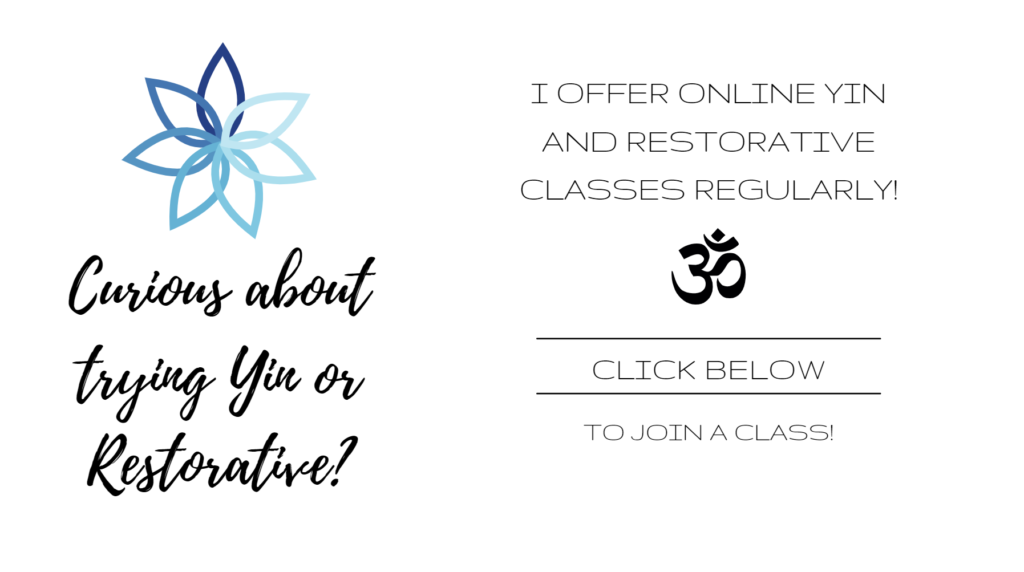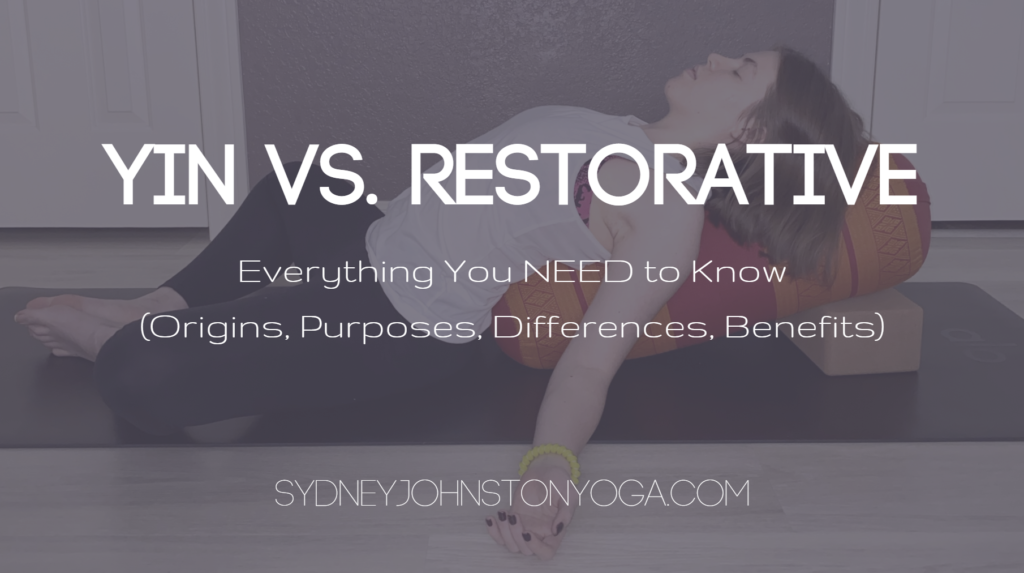In This Post:
- Overview of Yin and Restorative Yoga
- Origins
- Origin of Yin Yoga
- Origin of Restorative Yoga
- Purpose
- Purpose of Yin Yoga
- Purpose of Restorative Yoga
- Similarities and Differences Between Yin and Restorative Yoga
- Benefits
- Benefits of Yin Yoga
- Benefits of Restorative Yoga
- Conclusion: Is One Better Than the Other?
Overview of Yin and Restorative Yoga
If you’re like me, your first yoga class was likely a dynamic flow-based practice reminiscent of exercise. Lots of movement, trying desperately to balance in tree pose, and possibly even breaking a sweat. That’s what yoga is about, isn’t it?
Wrong. As time goes on, many students become curious about other types of yoga and temporarily diverge from – or even completely abandon – the original style of yoga they were introduced to in favor of other lineages. That’s when it becomes really fun. When you are open to exploring new styles of yoga, the types you can practice beyond vinyasa and hatha become almost limitless: Ashtanga, power, Kundalini, Iyengar, hot yoga, Bikram, Yin, and restorative – just to name a few.
Among the many styles of yoga out there, Yin and restorative stand out from the rest because poses are near to the ground, the body is supported, and postures are held for a long time. Keep reading to learn all about the origins, purposes, similarities and differences, and benefits of these unique yoga practices!
Origins
Yin Yoga
Yin yoga is different from any other style of yoga in that it originates from the Chinese Taoist tradition in addition to the Indian hatha lineage. Yin yoga has ties to Chinese medicine, the Chinese meridians (energy pathways in the body), and the concept of balancing opposites – yin and yang, black and white, sun and moon, effort and ease. ‘Yang’ is the activity, energy, noise, and busyness of our daily lives. But it must be balanced by ‘yin,’ which is ease, softness, surrender, quiet; thus, Yin yoga provides balance to the stress and chaos of daily life.
Restorative Yoga
Restorative yoga is a more modern practice that originated in India, rooted in the teachings of B.K.S. Iyengar, and has been popularized in the US in recent decades by Judith Lasater. It has since increased in popularity due to the balance it offers to the chronic stress and fatigue of daily life, and also because its accessible nature allows injured, sick, elderly, and pregnant practitioners to maintain a yoga practice.
Purpose
Purpose of Yin Yoga
The purpose of Yin yoga is to stretch the fascia and connective tissues (ligaments, tendons, etc.) instead of the muscles, so Yin is practiced with no muscular engagement – so no warming up or flow-based yoga before a yin practice. When muscles are “warm” (blood has been sent to the muscles in response to contracting and relaxing them), they will ‘steal’ the stretch from the fascia and connective tissues, which means the best times to practice are Yin in the morning and prior to physical activity.
There are 3 principles of Yin yoga:
- Find your personal edge: never go as far as possible into the pose. Stop at a sensation level of about 5 on an intensity scale ranging from 1 (nothing) to 10 (pain). You are always welcome to move further into a pose as the body releases, take a break from a pose, or back off if you find you have gone too far.
- Be still: the key to regaining presence through Yin is noticing the sensation in your body without fidgeting to distract yourself. Adjustments are encouraged and should be made (especially if you have gone too far into the pose!), but moving and fidgeting to distract oneself from mild discomfort are discouraged because they prevent you from becoming aware of the present moment.
- Hold the pose: each Yin pose is held for 3-5 minutes (sometimes up to 8 or 11 minutes) so that the fascia and tissues have time to release. During the hold, students should focus on the breath and sensation and attempt to let go of thoughts and worries.
Purpose of Restorative Yoga
If the purpose of Yin yoga can be summed up as physical release, then likewise the purpose of restorative yoga can be abbreviated as mental release. Restorative yoga is less focused on increasing flexibility and releasing the physical tissues, instead promoting nervous system health by giving the nervous system time to completely relax and restore. While restorative yoga does release physical tension and increase flexibility, the bigger benefit is that it helps us shift away from “fight or flight” mode (the sympathetic nervous system) and into “rest and digest” mode (the parasympathetic nervous system). This is proven to aid digestion, decrease stress and cortisol levels, and allow our bodies time to do their “housekeeping.”
Similarities and Differences Between Yin and Restorative
| Yin | Both | Restorative |
| Physical release of tissues | Increase flexibility | Mental release and relaxation |
| Poses held 3-5 minutes (commonly), or up to 11 minutes | Poses are held in stillness | Poses held longer than in Yin (usually 5-20 minutes) |
| Mild sensation while holding the pose (about a 5 on a scale of 1-10) | Poses are close to the ground | No sensation – the body is completely supported by the ground and props |
| Rooted in Chinese Taoist tradition | Provide a counterbalance to the chaos and stress of daily life through induced relaxation | Originated in the Indian hatha lineage |
| Students must breathe through sensation and discomfort, learning to maintain equanimity in the face of challenging situations | Promotes introspection | Allows students to stop thinking and just be in the present moment, which can be therapeutic due to the over-stimulating nature of daily life |
Benefits
Benefits of Yin
While the benefits of Yin yoga are numerous, here are some of the most important:
- Anxiety and stress relief (Yin yoga has even been found to be more effective at reducing anxiety than aerobic exercise)
- Increases flexibility
- Releases the fascia and connective tissues
- Improves awareness of the present moment
- Promotes introspection
- Improves ability to respond to challenging situations: learning to breathe through discomfort when holding Yin postures prepares us for facing difficult life circumstances when they arise
- Reduces risk factors associated with non-communicable stress-induced diseases
- Accessible to a wide population, including injured, elderly, and pregnant women
- Induces relaxation and helps to shift into the “rest and digest” parasympathetic nervous system
Benefits of Restorative
- Decreases stress and cortisol levels
- Allows mental release and relaxation
- Increases flexibility
- Improves digestion
- Boosts immune system
- May decrease fatigue and heal exhaustion
- Promotes introspection
- Accessible to a wide population, including injured, elderly, and pregnant women
- Induces relaxation and helps to shift into the “rest and digest” parasympathetic nervous system
Conclusion: Is One Better Than the Other?
As the above bullet lists demonstrate, many benefits of Yin and restorative yoga overlap. Neither is better than the other, and each style offers a unique experience. So is one better than the other? That depends on YOU. If you’re looking for a more mentally challenging practice associated with physical benefits, Yin may be right for you. On the other hand, if you’re looking for a supportive and nourishing practice that aids exhaustion and stress, you may decide to give restorative a go. I teach both Yin and restorative and find that students who like one often tend to like the other as well – so if you already practice one of these styles, you may find that you fall in love with the other as well!


